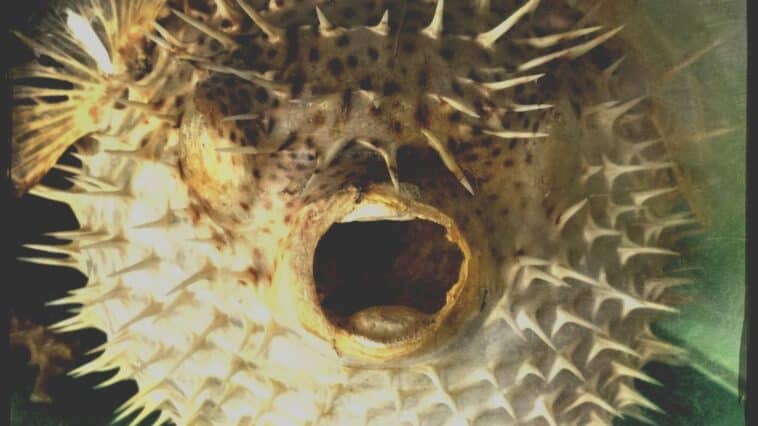Are you a fan of the ocean and all its creatures? Well, beware because not all fish are created equal. Some of them are downright terrifying. These 10 fish are not to be messed with, from sharp teeth to venomous spines. In this article, we’ll look at some of the scariest fish you’ll be glad you’ve never met. Whether you’re a seasoned diver or simply fascinated by the ocean, these creatures will have you on the edge of your seat. So, prepare to learn about some of the most fearsome fish in the sea, and be grateful that you’re not swimming alongside them.
What Makes a Fish Scary?
Beauty is in the eye of the beholder, and the same can be said for the scariness of a fish. However, certain characteristics of fish make them particularly scary to most people. For some, a fish with sharp teeth may be terrifying, while for others, a fish with poisonous spines may be the stuff of nightmares.
One of the most common features of scary fish is their appearance. Many have sharp teeth, a menacing appearance, or a large size that can be intimidating. Others have evolved unique survival mechanisms, such as the ability to deliver electric shocks or release venom. Some fish are also known to be highly aggressive, making them a danger to humans who come too close.
Whatever the reason, there’s no denying that some fish are just plain scary. Let’s look at some of the scariest fish in the sea.
The Fangtooth Fish
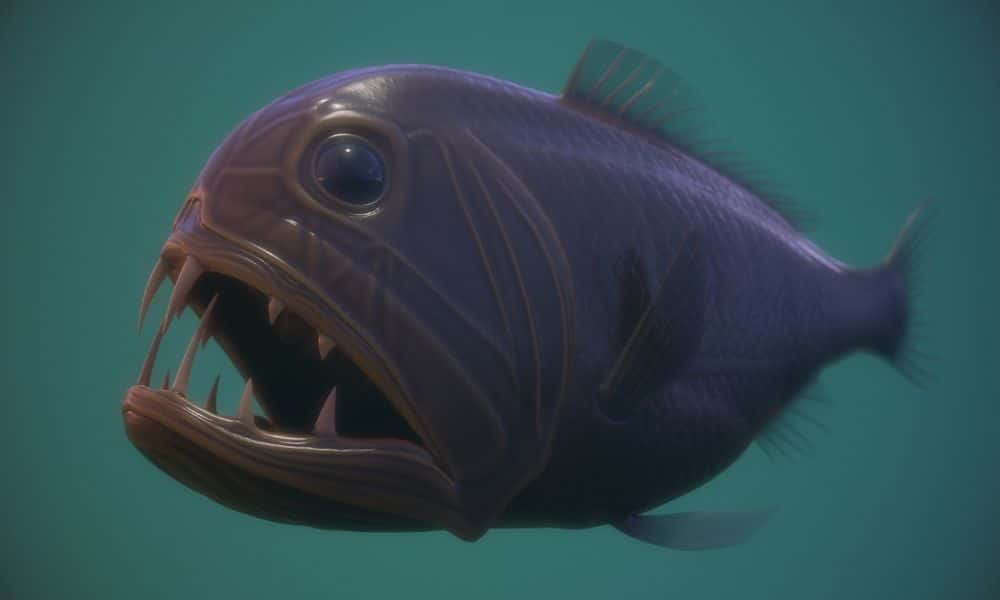
The fangtooth fish is a deep-sea fish known for its frightening appearance and unique adaptations. Here are some features that might be considered scary or intimidating about the fangtooth fish:
- Appearance: The fangtooth fish has a terrifying and grotesque appearance. It has an elongated body, large, sharp teeth, and a disproportionately large mouth compared to its body size. Its teeth are long and needle-like, giving it a menacing look. The fish’s appearance, bulging eyes, and hinged jaw contribute to its unsettling appearance.
- Adaptations for Deep-Sea Life: The fangtooth fish has several adaptations that allow it to thrive in the extreme conditions of the deep sea. It has a black or dark brown coloration that helps it blend in with its surroundings. Its large mouth and sharp teeth are designed for capturing and holding onto prey in the dark, deep-sea environment.
- Aggressive Predator: Fangtooth fish are fierce predators, using their large mouths and sharp teeth to capture and consume other fish and crustaceans. Despite their small size, reaching only about 6 inches (15 cm) in length, they have a voracious appetite and can overpower relatively large prey.
- Deep-Sea Habitat: Fangtooth fish live in the abyssal depths of the ocean, typically found at 6,500 to 16,000 feet (2,000 to 5,000 meters). Their habitat’s extreme darkness and pressure contribute to the overall mystique and scariness associated with deep-sea creatures like the fangtooth fish.
The Goblin Shark

The goblin shark is a deep-sea species with several unique and unusual features. While not inherently dangerous to humans, some aspects of the goblin shark can be considered scary or intimidating:
- Unusual Appearance: The goblin shark has a distinct and unsettling appearance. Its most notable feature is its elongated, protruding snout, which gives it a somewhat “alien-like” appearance. The snout contains sensory organs that help the shark detect prey in the ocean’s dark depths.
- Deep-Sea Habitat: Goblin sharks inhabit the deep sea, typically at depths ranging from 900 to 3,500 feet (275 to 1,070 meters). Their habitat’s extreme depths and darkness make encounters with these sharks rare for humans. The mysterious and unknown nature of the deep sea can contribute to a sense of fear or unease.
- Jaws and Teeth: The goblin shark has a unique jaw structure capable of rapidly extending forward to capture prey. When hunting, its jaws can shoot out from its mouth, extending to snatch unsuspecting prey. The goblin shark’s long, slender teeth are sharp and curved, adapted for gripping and catching slippery prey.
- Elusiveness: Humans do not commonly encounter Goblin sharks due to their deep-sea habitat and elusive nature. Their infrequent sightings and lack of direct interactions can contribute to the perception of them as rare and mysterious creatures, heightening the fear or fascination associated with them.
- Adaptations for Deep-Sea Life: The goblin shark has various adaptations that allow it to survive in the deep-sea environment. These adaptations include long, slender bodies, translucent skin, and highly sensitive ampullae of Lorenzini, which are electroreceptors that help detect the electrical signals emitted by prey. These unique adaptations can add to the shark’s eerie and otherworldly appearance.
The Stonefish

The stonefish is widely regarded as one of the most venomous fish in the world. Here are some aspects of the stonefish that can be considered scary or dangerous:
- Venomous Spines: Stonefish have venomous spines along their backs. These spines contain potent neurotoxins that can cause excruciating pain and potentially life-threatening complications. If someone accidentally steps on or touches a stonefish, the spines can penetrate the skin, injecting venom into the wound.
- Camouflage: Stonefish are masters of camouflage and can blend in perfectly with their surroundings, such as coral reefs, rocks, or sandy seabeds. They have a rough, warty appearance with colors that resemble rocks or coral, making them incredibly difficult to spot. This camouflage increases the risk of accidental contact with their venomous spines.
- Passive Defense Mechanism: Stonefish are not typically aggressive and rely on their passive defense mechanism. When threatened or disturbed, they remain motionless on the seabed, relying on their camouflage to go unnoticed. This behavior can make them particularly dangerous, as unsuspecting swimmers or divers may accidentally step on them.
- The potency of Venom: The venom of the stonefish is extremely potent. It contains a combination of neurotoxins that can cause severe pain, swelling, and tissue necrosis, potentially leading to cardiovascular and respiratory complications. If left untreated, a stonefish sting can be life-threatening, especially to individuals who are allergic or have pre-existing health conditions.
- Geographic Distribution: Stonefish are predominantly found in the Indo-Pacific region, including the coastal waters of Australia, Southeast Asia, and the Indian Ocean. Their presence in popular tourist destinations and recreational areas adds to the fear factor, as people may be unaware of the potential danger they pose.
It’s important to exercise caution and be aware of the potential presence of stonefish when swimming, snorkeling, or diving in areas where they are known to inhabit. Wearing protective footwear and staying vigilant can help reduce the risk of accidental encounters and stings. In a stonefish sting, seeking immediate medical attention is crucial.
The Electric Eel
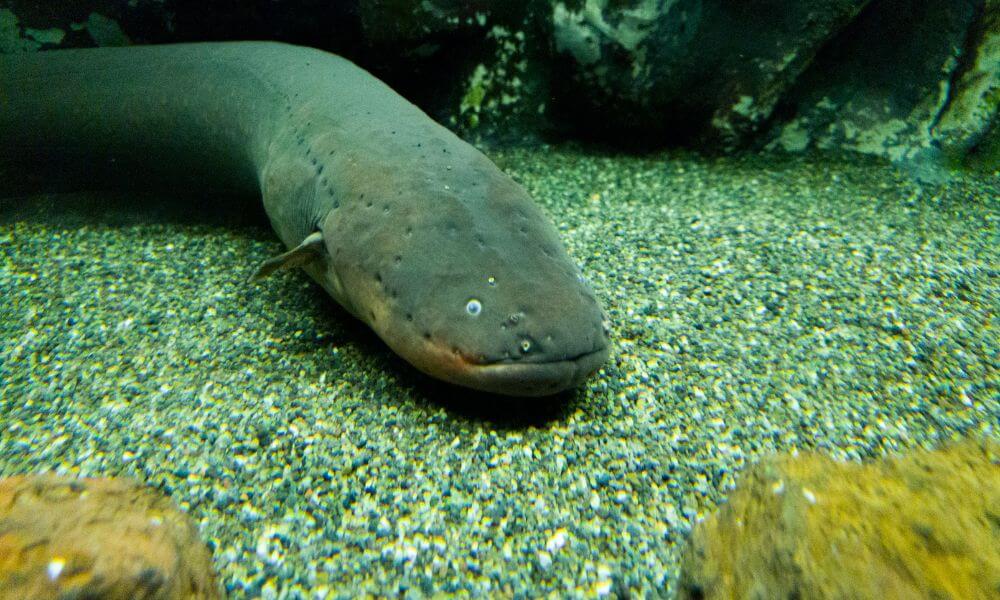
While electric eels are fascinating creatures, there are a few aspects that some people might find scary or intimidating:
- Electric Shocks: The electric eel’s ability to generate electric shocks can be powerful and potentially dangerous. A full discharge from a large electric eel can deliver a shock of up to 600 volts, which can cause significant pain and muscle contractions. While fatalities are rare, these shocks can threaten humans, especially if they occur in water where escape might be challenging.
- Size and Aggression: Electric eels can grow quite large, reaching lengths of up to 8 feet (2.5 meters) and weighing around 44 pounds (20 kilograms). Their size, combined with their ability to generate strong electric shocks, can make them intimidating. Electric eels can also exhibit aggressive behavior if they feel threatened, potentially leading to defensive attacks.
- Camouflage: Electric eels have a dark gray or brown coloration, allowing them to blend into their surroundings effectively. This camouflage can make them difficult to spot, especially in murky or vegetated waters. The ability to hide effectively can be unsettling for some people who might prefer to have a clear view of potential environmental threats.
It’s important to note that electric eels are generally not aggressive toward humans unless provoked or mishandled. While they may be intimidating, they are typically more interested in avoiding conflict and using their electric shocks for hunting and defense against their natural prey.
The Giant Squid
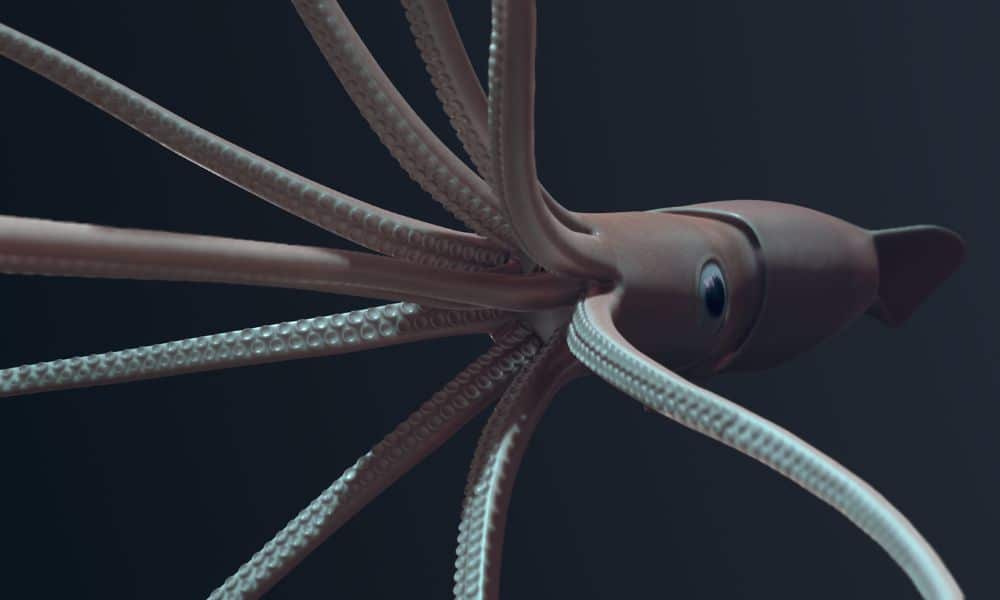
The giant squid is a deep-sea-dwelling creature that has captivated the human imagination for centuries. While they are not inherently dangerous or harmful to humans, there are aspects of the giant squid that some people might find scary or awe-inspiring:
- Enormous Size: Giant squids are among the largest known invertebrates, with adult individuals reaching lengths of up to 43 feet (13 meters). Their massive size, combined with their long, writhing tentacles, can be intimidating and evoke a sense of awe in those who encounter them.
- Elusive Nature: Giant squids are elusive and inhabit the ocean’s depths, typically found at depths of 1,000 to 3,000 feet (300 to 900 meters). Their remote habitat and infrequent sightings have contributed to their mysterious reputation and the fear or fascination associated with them.
- Deep-Sea Adaptations: The giant squid has a range of adaptations that allow it to survive in the extreme conditions of the deep sea. Its large eyes, the size of dinner plates, are adapted to perceive bioluminescent light in the dark depths. They also have long, powerful tentacles with suction cups lined with sharp, toothed rings, which they use to catch and subdue prey.
- Invertebrate Predator: Giant squids are formidable predators, preying on fish, other squids, and deep-sea creatures. They have been known to attack and devour marine animals that are significant in size, showcasing their impressive hunting abilities.
The Piranha
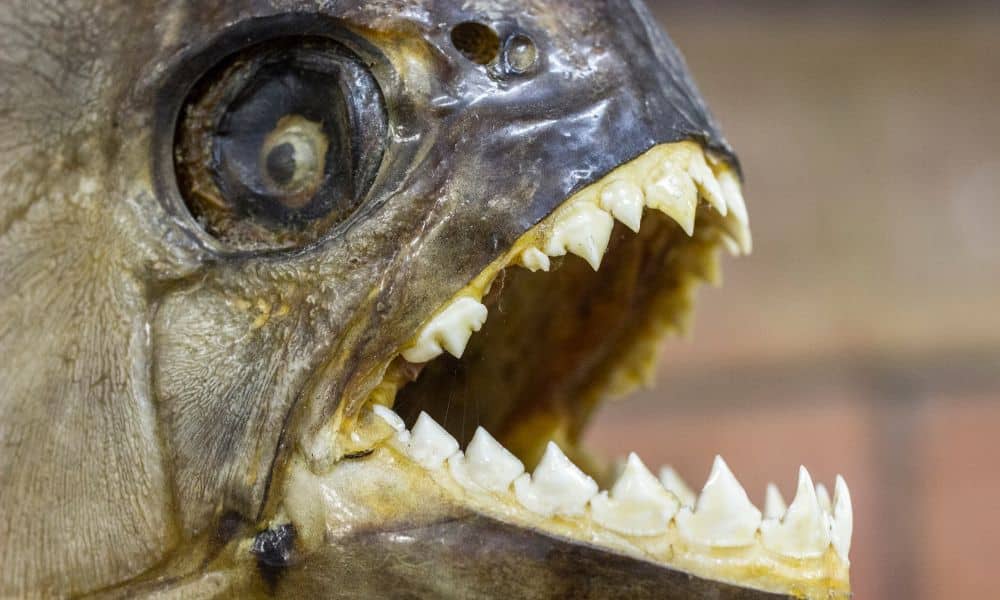
Piranhas are carnivorous freshwater fish found in South American rivers. While they have a reputation for being aggressive and capable of inflicting harm, it’s important to understand the context and separate fact from exaggeration. Here are some aspects that may contribute to the perception of piranhas as scary:
- Sharp Teeth: Piranhas have sharp, interlocking teeth well-suited for tearing flesh. Their teeth are often associated with their predatory behavior and ability to inflict wounds on prey or potential threats.
- Feeding Frenzy: When hungry piranhas encounter a large food source, such as a wounded animal or a carcass, they can engage in a feeding frenzy. During a feeding frenzy, piranhas may appear frenetic and aggressive as they rapidly devour the available food. This behavior has contributed to their reputation as voracious and dangerous creatures.
- Powerful Jaws: Piranhas have strong jaw muscles that allow them to exert considerable force when biting down. This biting power is utilized when capturing and consuming prey, reinforcing their image as formidable predators.
- Aggressive Defense: Piranhas exhibit territorial and aggressive behavior, particularly during the breeding season or when protecting their nests and offspring. In these circumstances, they may fiercely defend their territory and bite intruders, including humans, if they feel threatened.
The Viperfish
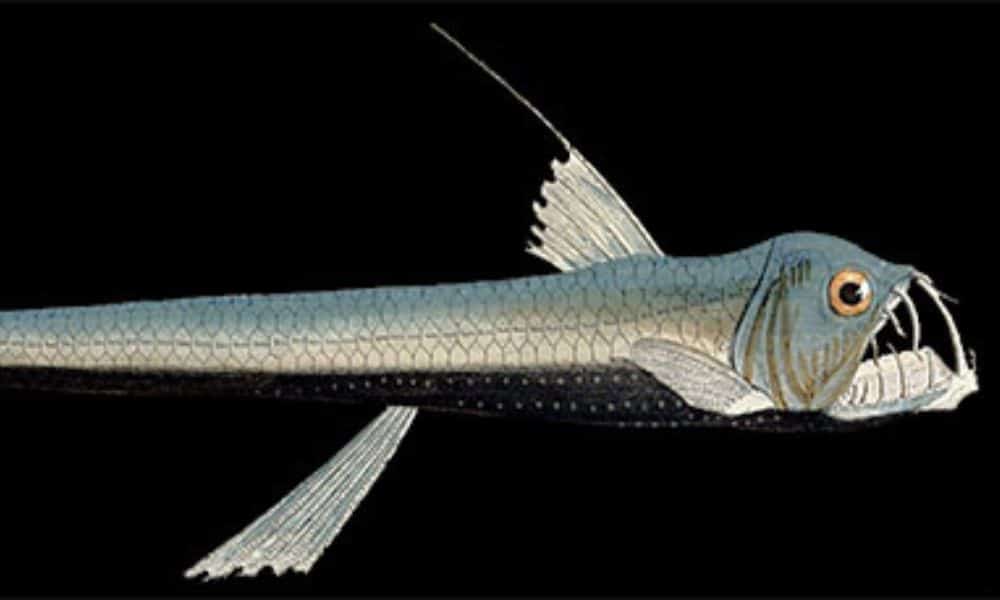
The Viperfish is a deep-sea fish known for its menacing appearance and unique adaptations. Here are some factors that might be considered scary or intimidating about the Viperfish:
- Enormous Teeth: The Viperfish has long, needle-like teeth that are disproportionately large compared to its body size. Its teeth are hinged, allowing them to fold back when the fish’s mouth is closed. When hunting, the Viperfish can extend its jaws and protrude its long teeth, creating a striking and intimidating appearance.
- Bioluminescence: Viperfish possess photophores, specialized light-emitting organs that allow them to produce bioluminescent light. They use this bioluminescence to attract prey in the deep-sea darkness. The combination of their glowing appearance and large teeth can contribute to their eerie and scary image.
- Deep-Sea Habitat: Viperfish inhabit the deep sea, typically found at depths of 1,000 to 13,000 feet (300 to 4,000 meters). The extreme depths and darkness of their habitat and the unknown and mysterious nature of the deep sea can add to the fear or fascination associated with the Viperfish.
- Predator Behavior: Viperfish are fierce predators that feed on smaller fish and other marine organisms. They have a voracious appetite and can capture relatively large prey compared to their size. Their aggressive hunting behavior, combined with their sharp teeth, can be intimidating.
The Lamprey
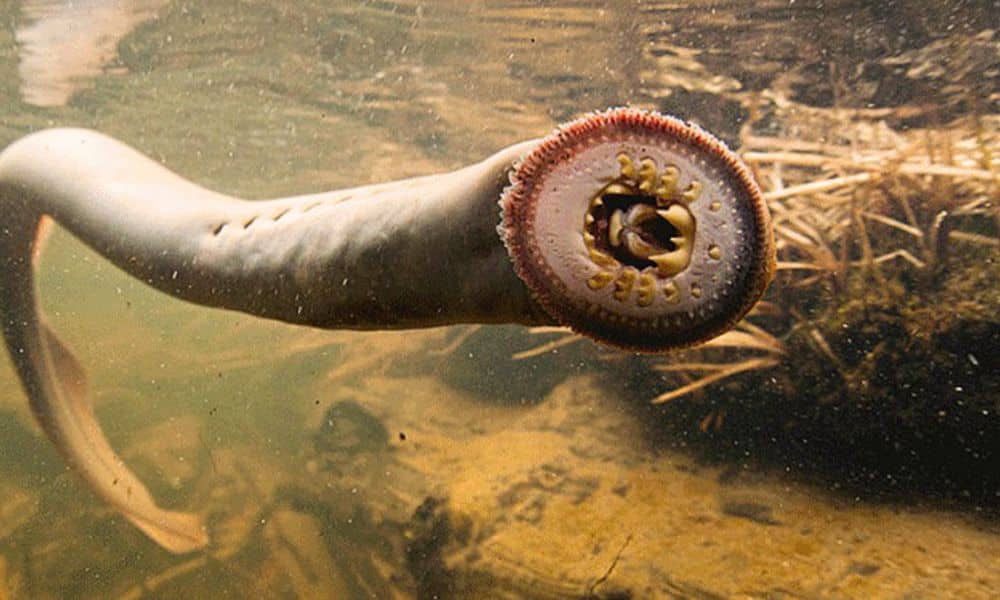
The Lamprey is a jawless fish known for its parasitic lifestyle and unique physical features. Here are some aspects that might be considered scary or unsettling about lampreys:
- Parasitic Behavior: Lampreys are known as parasites because some species attach themselves to other fish, using their round, sucker-like mouths filled with sharp teeth to latch onto their hosts. They feed on the host’s blood and body fluids, causing wounds and potential harm to the host.
- Circular Mouth and Teeth: Lampreys have a distinctive circular mouth lined with rows of sharp, inward-curving teeth. This mouth structure is designed to attach to hosts and feed on their flesh and fluids. The appearance of their mouth and teeth can evoke feelings of unease or fear.
- Bloodsucking Adaptations: Lampreys possess adaptations that allow them to feed on the blood of their hosts efficiently. They secrete anticoagulant substances to prevent the host’s blood from clotting, ensuring a steady flow of nourishment. Their ability to latch onto and feed on other fish can be seen as unsettling or scary.
- Invasion of Body Cavities: Some lamprey species are known to enter the body cavities of larger fish, such as the gills or the body cavity itself. This behavior can cause harm or even death to the host fish, as the Lamprey’s feeding activities may damage vital organs or impede normal functions.
- Eel-Like Appearance: Lampreys have long, slender bodies that resemble eels, adding to their somewhat eerie appearance. Their smooth, scaleless skin and cylindrical shape contribute to their unsettling image.
The Frilled Shark
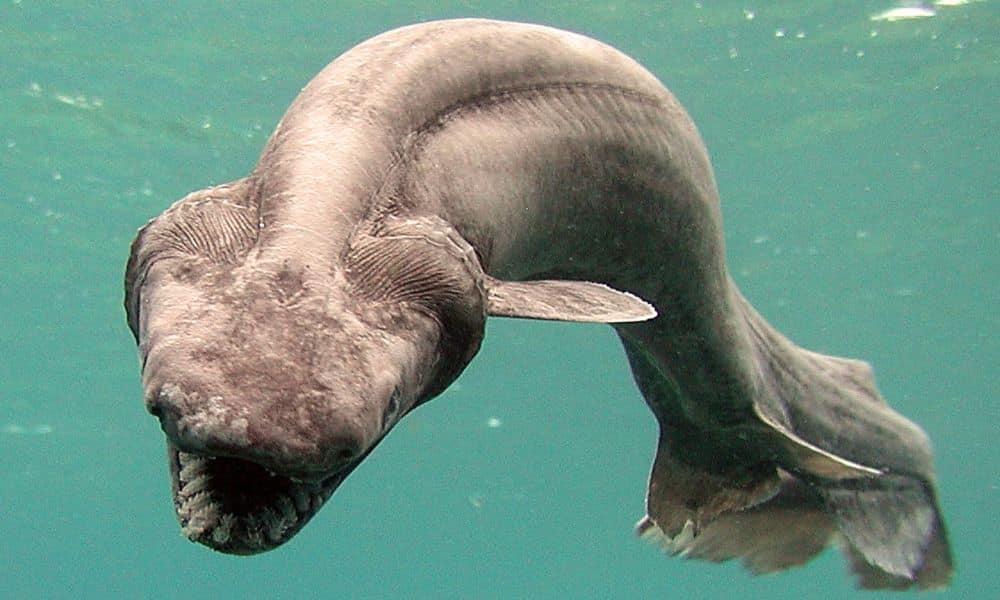
The frilled shark is a deep-sea species known for its unique appearance and adaptations. Here are some aspects that might be considered scary or unsettling about the frilled shark:
- Primitive Appearance: The frilled shark has a primitive and prehistoric appearance, resembling a creature from a bygone era. It has a long, eel-like body and a large, wide head with a mouth that extends far back along its head. Its overall appearance can evoke a sense of unfamiliarity and unease.
- Unusual Teeth: The frilled shark possesses numerous rows of sharp, needle-like teeth. Its teeth are curved backward, giving it a serrated appearance. This dental arrangement is designed to capture and hold onto slippery prey items, such as squid and other fish. The shark’s formidable teeth can contribute to its image as a fierce and dangerous predator.
- Elusive Deep-Sea Habitat: Frilled sharks inhabit the deep sea, typically found at depths ranging from 1,000 to 4,200 feet (300 to 1,280 meters). The deep-sea environment is dark, mysterious, and largely unexplored, adding to the fear or fascination associated with the frilled shark.
- Feeding Strategy: Frilled sharks are ambush predators that primarily feed on squid and other fish. They have a unique feeding behavior where they lunge forward, extending their jaws and swallowing their prey. This sudden and rapid feeding strategy can contribute to their intimidating reputation.
- Rare Encounters: Humans rarely encounter frilled sharks due to their deep-sea habitat and elusive nature. Sighting a frilled shark is considered a rare event, and their infrequent encounters with humans contribute to their mysterious and potentially intimidating image.
The Moray Eel
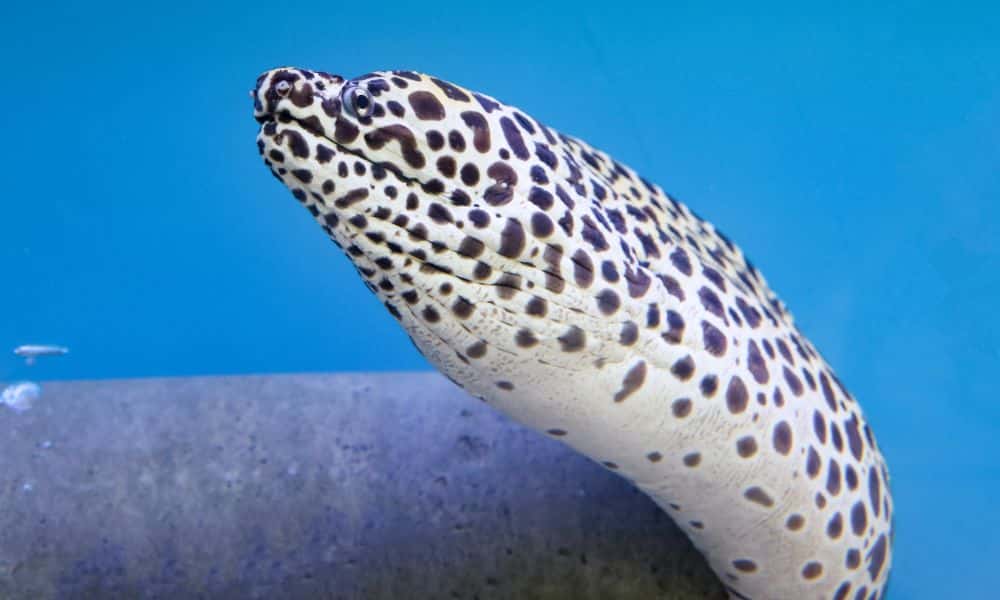
The Moray Eel is an eel-like fish found in saltwater and brackish environments. While they are not inherently dangerous or aggressive towards humans, there are some aspects that some people might find scary or unsettling about moray eels:
- Size and Appearance: Moray eels can grow to considerable lengths, with some species reaching up to 10 feet (3 meters). Their elongated jaws are filled with sharp teeth, often visible even when their mouths are closed. They have long, snake-like bodies covered in mucus, which gives them a slimy and slippery appearance.
- Powerful Bite: Moray eels have a strong bite and powerful jaws. Their teeth are designed to grip and tear apart prey, and they can exert substantial force when biting down. While they typically use their jaws for feeding, there have been instances where moray eels have bitten humans when provoked or when they feel threatened.
- Aggressive Defense: Moray eels can display territorial behavior and become aggressive when defending their hiding spots or feeling cornered. If a human attempt to reach into their crevices or holes, they may perceive it as a threat and bite in self-defense. However, unprovoked attacks on humans are extremely rare.
- Hiding Behavior: Moray eels are known for their ability to hide in crevices, coral reefs, or rocks, waiting for prey to pass by. Their ability to swiftly emerge from their hiding spots and sudden appearance can startle people, contributing to their perception of them as scary or unpredictable.
- Snakelike Movements: Moray eels move in a sinuous, snakelike manner, which can be unsettling for some individuals. Their flexible bodies and rapid movements can give the impression of unpredictability, making them appear more intimidating.
Conclusion
These 10 fish are some of the scariest creatures on earth, from the Fangtooth Fish to the Moray Eel. Whether it’s their sharp teeth, venomous spines, or unique hunting techniques, there’s no denying that these fish are not to be messed with. So, the next time you’re swimming in the ocean, just remember: some things in the deep are best left unseen.


